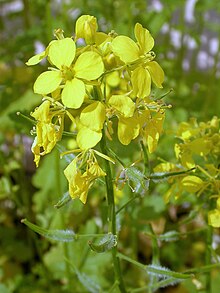Sinalbin
| Structural formula | |||||||||||||||||||
|---|---|---|---|---|---|---|---|---|---|---|---|---|---|---|---|---|---|---|---|
 
|
|||||||||||||||||||
| General | |||||||||||||||||||
| Surname | Sinalbin | ||||||||||||||||||
| Molecular formula | C 30 H 42 N 2 O 15 S 2 | ||||||||||||||||||
| External identifiers / databases | |||||||||||||||||||
|
|||||||||||||||||||
| properties | |||||||||||||||||||
| Molar mass | 734.83 g · mol -1 | ||||||||||||||||||
| Physical state |
firmly |
||||||||||||||||||
| Melting point |
|
||||||||||||||||||
| safety instructions | |||||||||||||||||||
|
|||||||||||||||||||
| As far as possible and customary, SI units are used. Unless otherwise noted, the data given apply to standard conditions . | |||||||||||||||||||
Sinalbin is a mustard oil glycoside that is contained in white mustard (2–2.5%), among other things . It is the salt of glucosinalbine with sinapine .
From sinalbin is by the action of the enzyme myrosinase , which in the cell is stored in another place of the plant, with the elimination of glucose , the oil of mustard released 4-hydroxybenzyl. This creates the typically sharp taste of mustard.
In contrast to allyl isothiocyanate , the vapor pressure of 4-hydroxybenzyl isothiocyanate is not that high, which is why the impression of sharpness is produced more in the oral cavity.
In contrast to sinigrin , whose hydrolysis products are not stable in an acidic environment, the product of sinalbin is stable over a long period of time.
swell
- ↑ a b c Entry on glucosinolates. In: Römpp Online . Georg Thieme Verlag, accessed on June 16, 2013.
- ↑ This substance has either not yet been classified with regard to its hazardousness or a reliable and citable source has not yet been found.
